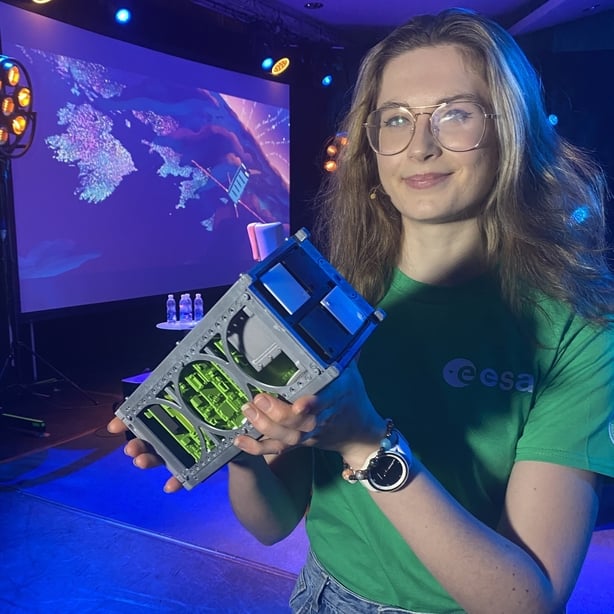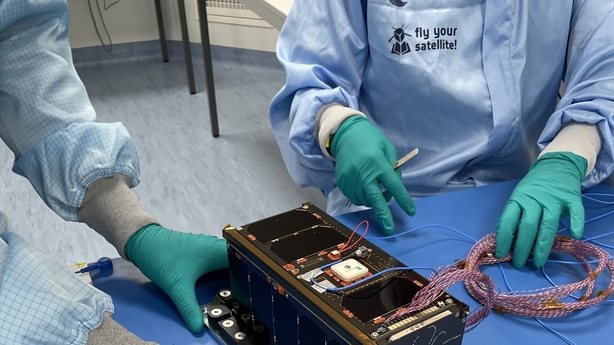In what represents a major milestone for Ireland's emerging space industry, academics, students and engineers from University College Dublin witnessed their EIRSAT-1 satellite being launched into space this evening following more than six years of research, design and building.
Among those who were excitedly watching the culmination of the 'Fly Your Satellite!' project as the SpaceX Falcon 9 rocket lifted off from Vandenbeg Air Force Base in California, was PHD physics student Laura Cotter.
Holding a 3D to-scale model of the satellite, she explained the three different experiments she hopes it will be able to deliver information on.
The primary one is the GMOD detector, which is designed to detect gamma ray bursts.
"That's what I study in my field of research. Gamma ray bursts are these huge massive explosions that happen very far away in space, when a star dies and they eject matter and particles into space in the form of jets and they move at really, really high speeds.
"There's a lot we don't know about these different astrophysical phenomenon, so that's why it's really important to have detectors like this."

The gamma rays that they are seeking to observe can be caused by stars exploding at the end of their lives or black holes or neutron stars merging together to form the explosions.
Synthetic crystals inside the box will light up in a flash if they are hit by a gamma ray and readings can then be sent from the satellite back to Earth.
They are also testing how satellites can be protected in space with the chequerboard pattern on the outside of the satellite, painted solar black and solar white. This will test how this surface coating will be in earth's low orbit.
"Ireland can play a really exciting role" - Professor Orla Feely
There is also software on board that will be tested to help control the satellite's orientation.
We need your consent to load this rte-player contentWe use rte-player to manage extra content that can set cookies on your device and collect data about your activity. Please review their details and accept them to load the content.Manage Preferences
Professor Sheila McBreen, an astrophysicist from the School of Physics in UCD, is one of a team of academics involved in overseeing the project from the very beginning.
She said 50 students have come through the project, not only those in the Department of Physics but also those involved in Mathematics, Computer Science and Mechanical Materials Engineering.
"This is a step-change for us. The students have had direct training in how to design, build, integrate, assemble, test, verify experiments and a satellite for space and now they're going to operate that satellite ... those are skills you can't learn on paper," said Prof McBreen.

Another student, Caimin McKenna is taking on the role of the first point of contact for the satellite and he will help to confirm that it is in good working order. "It's been a lot of work," explains Mr McKenna.
He said the most terrifying part of the project is making sure the satellite survives its launch.
"Because this is when you have all the shaking and the vibrations and stuff. If we can make contact then we can be relieved that it survived and we can get some good science out of it," he said.
The contact will happen when the satellite is directly above Ireland, which he said will happen two or three times in the morning and two or three times in the evening in Ireland, due to the orbit we are in.
"It's Irish components, Irish-tested equipment, Irish students' hard work and code, up in space looking down at us. That will make us really proud."
In the latest update, the cube satellite had successfully deployed from the rocket and injected into low earth orbit.
Welcoming the launch, Hugo Marée, Head of the Education Office at the European Space Agency said: "All I can say is mission accomplished.
"For us, we have accompanied the student teams, to develop the satellite, to test it and then to prepare it for launch so we have had basically 100 colleagues all across ESA, in engineering, in operations, in legal, in procurement who did help to make it possible."
Professor Orla Feely, the President of UCD, said she was proud of what has been achieved so far.
"The notion that a satellite that was imagined and designed and built in Belfield, where we worked with school children to compose a poem in celebration of the voyage that is etched on the side of the satellite. It's a wonderful, inspirational story and we are so proud of it," she said.
Prof Feely said there was now a focus on developing a full space sector for Ireland.
"This is a sector that is a huge business that really plays to Ireland's strengths," she explained.
"It builds on our expertise in tech, in data science, areas like insurance and logistics of space, so there's so many areas where Ireland can play a really exciting role."
Prof Feely said it was exciting that the satellite would look at the very origins of the universe and it was inspirational to think there would be a little bit of Ireland passing by in the night skies.
Professor Lorraine Hanlon, Director of EIRSAT-1 and the UCD Centre for Space Research (UCD C-Space), said the team had delivered a "thrilling result of Ireland in space"
"The next step now is to get used to operating our new spacecraft and get the maximum research and training out of it."
Dozens of UCD students, including nine PhDs candidates, worked with experts from the European Space Agency (ESA) to design and build EIRSAT-1 over the last six years.
There were cheers and sighs of relief from students and staff who watched the successful launch on screens in UCD this evening.
Recognising the project as an official Irish space mission in 2022, the Government said its successful launch marked a "a major milestone" for the growing space industry in Ireland.
Minister of State for Business, Employment and Retail Neale Richmond offered his congratulations.
"History was made here today, and everyone should be proud of the part they played in this milestone for Ireland and its space sector," he said.
Additional reporting: Brian O'Donovan






